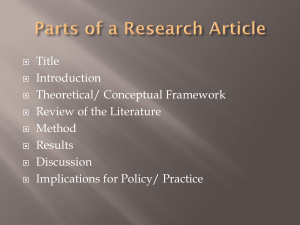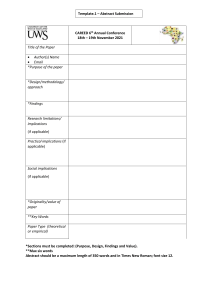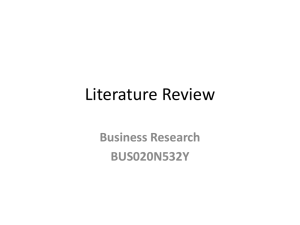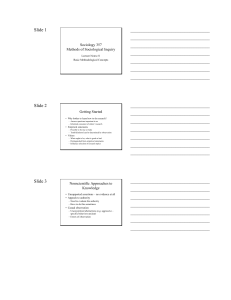Article Structure: Empirical, Theoretical, Philosophical Papers
advertisement
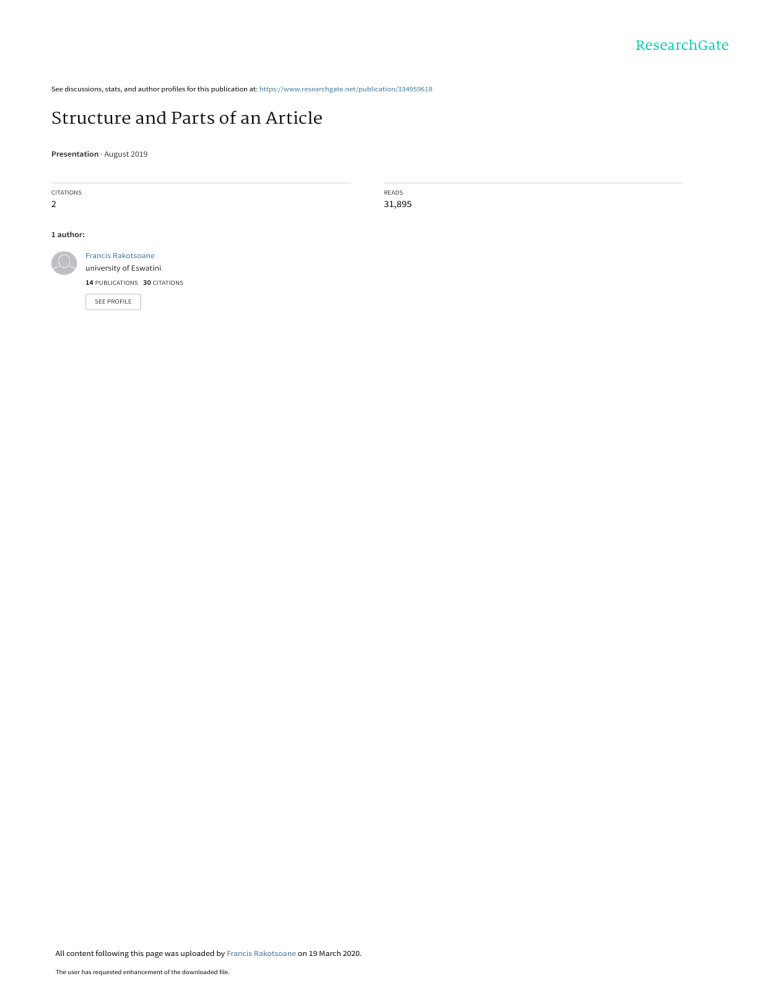
See discussions, stats, and author profiles for this publication at: https://www.researchgate.net/publication/334959618 Structure and Parts of an Article Presentation · August 2019 CITATIONS READS 2 31,895 1 author: Francis Rakotsoane university of Eswatini 14 PUBLICATIONS 30 CITATIONS SEE PROFILE All content following this page was uploaded by Francis Rakotsoane on 19 March 2020. The user has requested enhancement of the downloaded file. Structure and Parts of an Article Presented By Francis C.L. Rakotsoane At the National University of Lesotho, Roma 2019 1 1. Main Types of Research Papers Research papers are broadly divided into empirical and theoretical papers. Empirical Research Paper • The author reports on his or her own study. • The author will have collected data to answer a research question or address an issue/problem at hand. • Usually contains observed and measured examples that inform or answer the research question. • Data collection methods for empirical paper include interviews, surveys, questionnaires, observations, experiments, and various other quantitative and qualitative research methods. • Usually uses what is called an IMRAD (Introduction, Methods, Results and Discussion) structure. Theoretical Research Papers • A research paper in which the author supports his/her claim without relying on interviews, surveys, questionnaires, observations, experiments, or other kinds of new data. • The author‟s arguments depend entirely on theoretical research in available scholarly literature in the form of articles in scientific journals, official documents, books, newspapers and so forth). • Generally introduces and discusses abstract ideas and principles, either new or established that are related to a specific field of knowledge, with a particular focus on ideas formulated to explain, predict and understand phenomena. • Established theories are often introduced, described, analysed and compared as the author uses them to develop and present his or her own new theory about a problem, question, behaviour, situation, event or anything else worthy of reflection and discussion. 2. Structure of a Journal Article: A. For an Empirical Research Paper The following is the structure of a theoretical paper: • • • • Abstract Keywords Introduction Methods 2 • • • Results Discussion Conclusion Abstract This provides a summary of the article. • Usually 150-250 words long • Preferably written in one paragraph • Covers the following about the article: The problem /issue/question addressed by the article Method(s) used The main results The main conclusions An abstract should not contain • lengthy background information, • references to other literature, • elliptical (i.e., ending with ...) or incomplete sentences, • abbreviations or terms that may be confusing to readers, • any sort of illustration, figure, or table, or references to them. (http://abacus.bates.edu/~ganderso/biology/resources/writing/HTWsections.html#in troduction) Keywords 6-8 keywords are given immediately after the abstract in the article. • They should be words or phrases the reader searching for the article in question would use in their search • They could be single words or phrases • They do not include prepositions or articles • They should represent key concepts • They should reflect a collective understanding of the topic • They should be descriptive • They should contain words and phrases that suggest what the topic is about Introduction • Gives background information or the problem/question/issue to be addressed necessary context for the • Describes what emerges from this context as the problem/question/issue that needs to be addressed including what the author intends to do with it. • In other words, through it the author gives a scenario within which he/she identifies what he/she sees as the problem/question/issue and what he/she intends to do with it. 3 Methods • Explain clearly how the author proceeded methodologically when addressing the problem/question/issue at hand. • May also include how the author organized or structured the article. Results • Reports the findings of the study • Provides statistical documentation to demonstrate whether the results are valid and reliable. Discussion • Describes what the findings mean. • Relates the findings back to the problem/question stated in the introduction and to the findings of other scholars as reflected in the literature review. • Explains how results contribute to the existing body of scientific knowledge. Conclusion After the discussion section, comes the conclusion of the article. • Summarizes the results and discussion • Describes limitations of the study and suggests areas for further research/action. B. For a Theoretical Research Paper The following is the structure of a theoretical paper: • • • • • Abstract Keywords Introduction Body Conclusion Abstract As in the case of an empirical paper. Keywords As in the case of an empirical paper. Introduction • States the general purpose of the paper 4 • Provides the necessary context for the research problem or the issue at hand. • Sets the scene by showing what is already known from prior related or similar research and attempts to identify a gap (the problem) in this knowledge. • Elaborates on how the paper is going to fill the gap identified in what is already known. • Provides methodological procedures to be followed as well as how the paper is to be outlined to drive the author‟s point home. Body N.B.: There is no special section labeled „body‟. • The information gathered is presented in sub-headings immediately after the introduction section. • These are presented according to the paper‟s outline as will have been spelt out in the introduction of the paper. • They are arranged such that they argumentatively drive the author‟s point (main argument) home. Conclusion The same as in other research papers. C. For a Philosophical Research Paper A philosophical paper has a distinct style that differs greatly from most other research papers. It is meant to critically analyze concepts. Thus it works with concepts of things, not necessarily things themselves. • The abstract and keywords are written the same way as in other types of research papers. • The paper‟s introduction starts by stating what the problem/issue the author is going to address is. • This is followed by a summary of the most influential discussions and debates regarding the problem/issue to be addressed. • The author then outlines his/her own approach and how it relates to what others have said. • This is followed by the author‟s proposed argument, indicating the order in which he/she intends to address various points. • As he/she puts forward the argument, the author should at the same time pre-empt any potential arguments against his/her own argument. 5 • The conclusion is written the same way as in other types of research papers. • N.B.: This way of writing can be used in basically all theoretical/conceptual papers. Conclusion • Although these three types of research papers have been presented as being different from each other, in reality there is a lot of overlapping in the way people write articles. • That is, one and the same article can, at times, bear features of all of them together at the same time. Useful Sources • Day, R.A.1998. How to Write and Publish a Scientific Paper, 5th Edition. Phoenix: Oryx Press. • Fischer, B.A., Zigmond, M.J.2004. Components of a Research Article. www.survival.pitt.edu. • Jansen. J. 1997. “Academic Publishing: Notes for Beginning Researchers.” Lesotho Journal of Teacher Education 1 (1): 64-67. • Kotzé, T. 2007. Guidelines on Writing a First Quantitative Academic Article (2nd Edition). Pretoria: University of Pretoria. • Rakotsoane, F.C.L. 2018. Writing a Research Proposal: A Step-by-Step Guide for New Researchers. Roma: Choice Publishing Company. • Turnbow, D. 2019. Anatomy of a Journal Article. University of California: UC San Diego Libraries. 6 7 View publication stats
